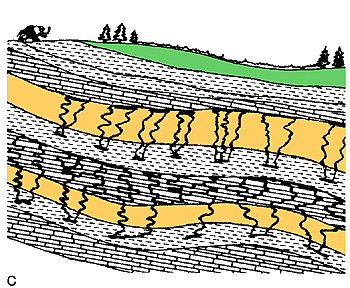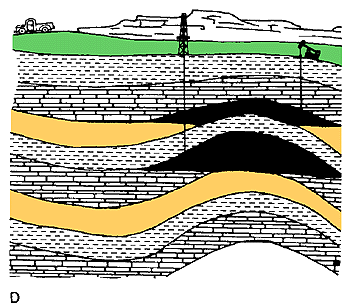


Petroleum: a primer for Kansas, Page 2 of 15
Prev Page--Start ||
Next Page--Geology of Petroleum
Introduction
The petroleum industry is a major contributor to the economy of Kansas. More than 350,000 wells have been drilled within the state in the search for oil and gas, and they have produced more than 5 billion barrels of oil, with an estimated 11 billion barrels of oil remaining underground. Yet most lay people in the state of Kansas know very little about how petroleum occurs, how it is discovered, or how it is produced once found. The purpose of this book is to describe the many complex processes involved in the formation of oil and gas pools, exploration and drilling methods used to find them, and the production of petroleum that has been found, in understandable language.
The Kansas Geological Survey is a repository for many types of data obtained in the process of petroleum exploration and production. We store drill cuttings and cores from thousands of wells, we file various well logs obtained from boreholes, and we compile the voluminous data accumulated through more than 100 years of drilling. Computer data bases are maintained for industry study and research. Data are evaluated, interpreted, and published as free or inexpensive information for the public. Extensive libraries of publications, including technical reports and maps, are available at the Kansas Geological Survey, and at the University of Kansas, Kansas State University, Wichita State University, Fort Hays State University, and Emporia State University.
Further information may be obtained from the Kansas Geological Survey, 1930 Constant Avenue, Lawrence, KS 66047-3726 or the KGS Well Sample Library, 4150 Monroe Street, Wichita, Kansas 67209.
Petroleum
Petroleum is a substance, usually liquid or gas, consisting of organic molecules composed of hydrogen and carbon atoms. Thus the general name "hydrocarbons" is often used. The possible variations in the construction of the molecules and mixtures of different molecules to form naturally occurring oil (crude oil) are virtually limitless. No two crude oils are identical. Because these complex mixtures of organic matter are found in rock, they are called "petroleum," a word derived from the Latin words for rock (petra) and for oil (oleum).
Most petroleum is formed from organic matter, tiny particles of plant and animal debris that accumulated with mud deposited in stagnant bodies of water. The original organic material was mostly microscopic marine plants and animals that lived in open seas, but much of it may have been derived from land plants and carried by streams to the site of deposition (fig. la). Despite stories you might have heard, dinosaurs did not contribute to the original soup. Organic material is easily destroyed by exposure to air. Deposition of the material must be rapid in waters containing little or no oxygen due to water stagnation. Where water is oxygen deficient and chemical reactions take oxygen atoms away from molecules it is said to be a "reducing" condition, a requirement for the preservation of organic matter. Also, low-oxygen environments greatly decrease the number of scavengers that might otherwise consume and destroy the organic morsels. Usually the proper conditions occur in quiet marine basins, lagoons, and rapidly buried delta deposits, but similar conditions prevail in some lakes.
Figure 1a--This diagram shows life existing in an ancient sea hundreds of millions of years ago and burial of organic matter in the sediments.

Once the fragile organic matter is preserved from oxidation and scavengers, it must be buried to considerable depths, usually more than 5,000 ft (1,524 m), by more sediments (fig. 1b). Compaction from the weight of the overburden changes the deposits to rock (shale) by compressing the clay and organic particles and expelling the contained water. Bacterial and chemical actions, aided by elevated temperatures, begin the long, complicated process of transforming the organic material to hydrocarbons. No one thoroughly understands the complexities involved, but great heat and pressure from deep burial over millions of years are required to complete the process.
Figure 1b--Millions of years later, life still exists in a shallow sea and the sediments have increased in thickness. The organic matter is being altered into petroleum.

The beds of sedimentary rock in which the petroleum is formed are called the "source rocks." They are usually dark gray or black shales, but limestone is a source under some conditions. Shale has an abundance of pore space between the clay particles which can contain liquid, but the pores are much too tiny to allow the movement of fluids under normal conditions. In other words, shales are not "permeable." However, the pressure produced by the processes of petroleum generation expels the fluid, and petroleum has to move from the source rock at some stage of development to become economically producible. The event is called "primary migration." Once departed from the source bed, the oil or gas will enter any nearby porous and permeable rock, such as sandstone or limestone.
Oil and natural gas are less dense than water and, for all practical purposes, are insoluble in water. If the fluids are mixed, oil and gas rise to the surface of the water. Rocks beneath the water table are, by definition, saturated with water. Petroleum leaving the source rock enters a water-wet rock and must try to rise to the top of the porous layer. If the porous rock is also "permeable," that is, fluids can pass from one tiny pore to another or "flow" through these tiny channelways in the rock, the petroleum will rise until it reaches impermeable rock above. Keep in mind that pores in most rocks consist of tiny spaces between the sand grains or crystals. The pores must be interconnected for fluids to pass from one pore to the next, and the connecting opening must be larger than a hydrocarbon globule for movement to occur. Such movement of petroleum after leaving the source rock is called "secondary migration."
Figure 1c--The sea no longer exists. Petroleum is migrating from the source rocks into porous rocks.

Threads and tiny globules of oil or bubbles of natural gas collect at the top of the porous-permeable rock layer (fig. 1c). Such accumulations are usually too small to be recovered practically from a well. However, if the rocks are tilted somehow, the petroleum will continue to migrate up the sloping top of the bed until it reaches the surface or an impermeable barrier to its flow (fig. 1d). The measured inclination of a rock layer is said to be the "dip" of the rock. If the petroleum reaches the surface of the earth at an "outcrop" of the rock layer, it flows onto the surface as an oil or gas "seep." This is how oil was first discovered in Kansas, in Miami County in 1860, shortly after the Drake discovery in Pennsylvania. If the petroleum rises to an impermeable limit it is said to be trapped. An "oil trap" is any natural barrier to the up-dip migration of petroleum; and huge amounts of oil and/or natural gas may accumulate, such as at the El Dorado oil field northeast of Wichita and in the Hugoton gas area of southwestern Kansas.
Figure 1d--The rocks have been folded forming an anticline. The petroleum is trapped at the crest of the anticline.

Prev Page--Start ||
Next Page--Geology of Petroleum
Kansas Geological Survey, Education
Placed online April 2001
Comments to webadmin@kgs.ku.edu
The URL for this page is HTTP://www.kgs.ku.edu/Publications/Oil/primer02.html




